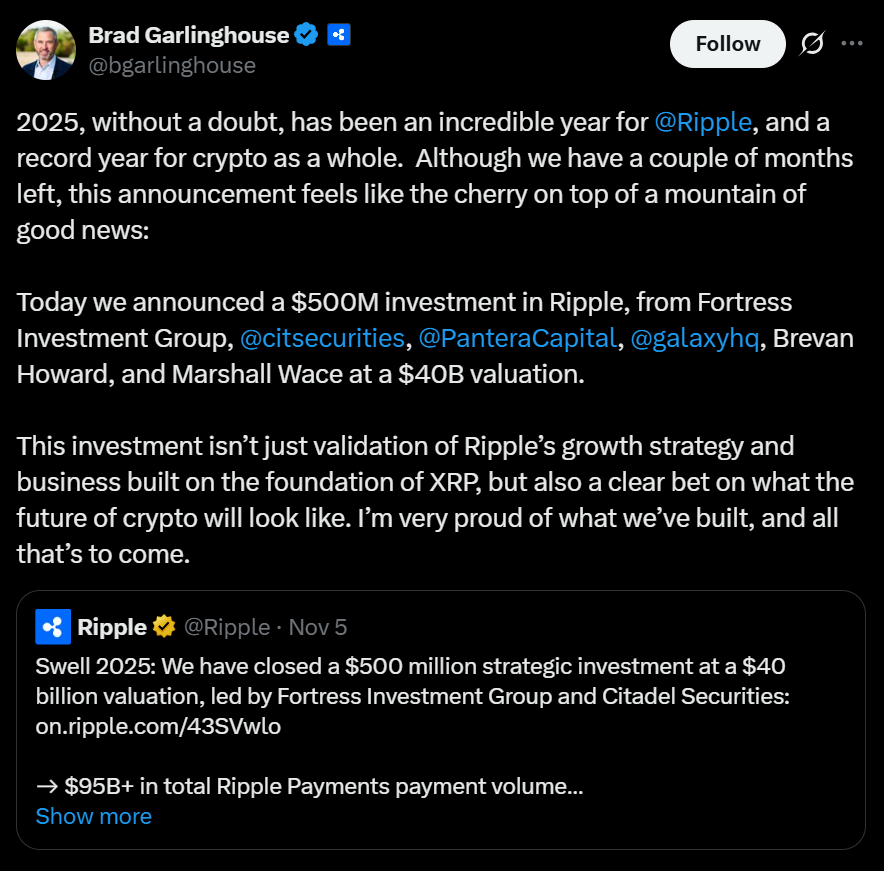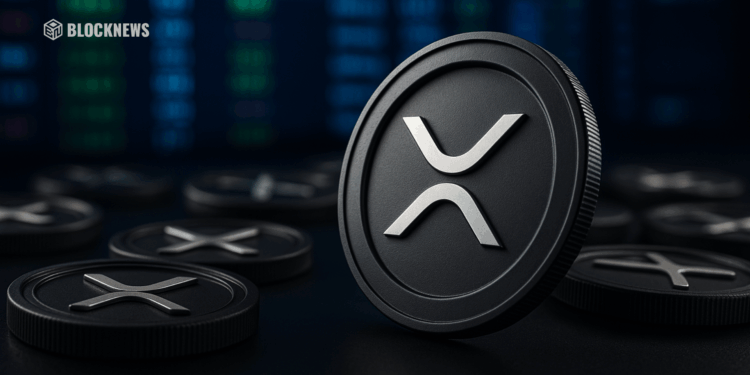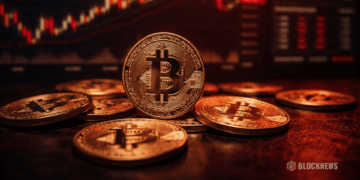- Ripple has spent nearly $4B in 2025 acquiring TradFi firms like Hidden Road and GTreasury, while launching Ripple Prime and lifting its valuation to $40B.
- The company aims to use XRP Ledger and its new acquisitions to deliver crypto-enabled financial services directly into traditional institutions’ workflows.
- Regulatory uncertainty in the U.S., especially around the stalled Clarity Act and the ongoing government shutdown, is still the main bottleneck for deeper bank integration.
Ripple Labs may already be one of the biggest names in crypto, but inside the company, that label is starting to feel too small. Speaking at the Ripple Swell 2025 conference in New York, CEO Brad Garlinghouse told CNBC that the firm is now firmly aiming beyond the Web3 bubble and deep into traditional finance.

The goal isn’t just to help banks move money faster with blockchain rails. Garlinghouse says Ripple wants to offer a full stack of financial services — brokerage, treasury tools, crypto liquidity — all built on blockchain infrastructure and designed for institutions that are finally warming up to digital assets.
“I want to see Ripple invest in [the] future and get ahead of where that market’s going,” he said. “The assets we have been buying have been on the traditional finance side, so we can bring crypto-enabled solutions to that traditional financial world.”
A $4 Billion Shopping Spree Aimed Squarely at TradFi
That “buying” is not a figure of speech. In 2025 alone, Ripple has gone on close to a $4 billion acquisition spree.
In April, the company acquired prime brokerage Hidden Road for nearly $1.3 billion, giving Ripple a direct foothold in institutional trading and balance sheet services. Later in the year, it snapped up GTreasury — a long-established treasury management software firm — for over $1 billion, placing Ripple squarely inside the workflows of corporate finance teams.
Last week, Ripple rolled out Ripple Prime, a new brokerage aimed at U.S.-based institutions, offering OTC spot trading across several tokens. In the same breath, the firm raised $500 million in fresh funding and pushed its private-market valuation to about $40 billion.
All of this is happening against a backdrop where U.S. regulators have eased off slightly under President Donald Trump. The SEC and CFTC have dialed back some of their most aggressive stances on digital assets this year, while big banks have started dipping in more openly:
- Bank of America and Citigroup are actively exploring stablecoins.
- Citi is preparing a crypto custody service for 2026.
- JPMorgan has announced plans for a “deposit token” on Base, Coinbase’s public blockchain.
- Institutional investors have poured billions into spot Bitcoin ETFs since their U.S. launch in early 2024.
“The United States used to lean out on crypto, and now we’re leaning in,” Garlinghouse said. “And I think people underestimate how big a shift that is, and what that means for the entire market.”
XRP Ledger as Infrastructure for Institutions
Beyond buying companies, Ripple also wants to rent out its tech. Garlinghouse says the firm is actively looking to sign deals where large institutions use the XRP Ledger (XRPL) as part of their own crypto or payments strategies.
XRPL is built for fast, low-cost transactions, and Ripple sees it as the core infrastructure layer for settlement-heavy use cases: cross-border payments, tokenized value transfer, maybe even future stablecoin flows.
“The more we can build utility and really scale solutions that take advantage of XRP at the core, the more that will be uniquely good for the XRP ecosystem,” Garlinghouse noted.
So far, though, XRP’s price hasn’t followed the narrative. The token has mostly traded sideways through 2025, even as Bitcoin and Ether hit fresh records near $126,000 and $3,900 respectively. For now, the market is still treating XRP more cautiously than the blue-chip majors, despite the noise around partnerships and infrastructure deals.

Regulation: The Friction Ripple Can’t Just Buy
If there’s one thing money can’t accelerate right now, it’s U.S. rulemaking. Garlinghouse was blunt about the main drag on deeper bank partnerships: regulatory clarity is still stuck in neutral.
The industry had hoped Congress would pass the Clarity Act, a comprehensive digital asset market structure bill, before year-end. That optimism has more or less evaporated. With the U.S. government shutdown entering its sixth week, legislative work on crypto has basically hit pause.
“Until we have that [legal go-ahead], it’s gonna be hard,” Garlinghouse said. “Banks are looking for and need that clarity for them to really lean in.”
That puts Ripple in a weird in-between state. On one side, it’s building out a serious, very expensive TradFi footprint and pitching itself as a bridge between the old rails and the new ones. On the other, the legal guardrails that big institutions want are still missing, which slows down the very adoption Ripple is trying to accelerate.
For now, the company is doing what it can control: acquire, build, and position itself for the moment regulators finally catch up. When that happens, Ripple clearly wants to be standing in the middle of the intersection between blockchain infrastructure and traditional finance, not watching from the sidelines.














